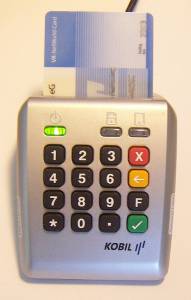A credit card is ubiquitous in today’s fast-paced society. The invention of credit cards has revolutionized the word, perhaps due to the fact that this object has made transactions faster, more secure, and trackable. What many forget is that the most important feature of a credit card is the black stripe often found at the back of the card. It is this glossy, dark, laminated plastic stripe that makes it possible to store data and make purchases with just a swipe. With electromagnetism, a piece of plastic turns into a tangible piece of information with immense power.
Introduction
Imagine yourself at the shopping mall, buying some new trendy clothes and you are about to pay the cashier. The total cost of your purchase is $200, but you realize that you do not have enough money in your wallet. Consequently, you slip out your credit card from your wallet and hand it to the cashier.
She takes the card and swipes it through a card reader. After a few seconds, the young woman hands back your card with a receipt, a thank you, and a generous smile. In that particular moment, you might wonder, “What just happened?”
The answer lies on the back of your card. The black stripe, also known as the magnetic stripe, is what makes this possible.
History
Magnetism has added much to recent technological advancements, from medical to commercial advanced. While the principle of magnetism has been with us since the dawn of time, humans had yet to utilize its full potential until 1821. A Danish scientist named Hans Christian Oersted encountered a strange phenomenon. Oersted noticed that when a compass is in close proximity to a wire that has electric current applied to it, an invisible force causes the needle of the compass to move. Later studies done by renowned scientists like Andre-Marie Ampere and Michael Faraday have helped to explain this strange phenomenon: magnetism [1].
Since then, scientists have made numerous groundbreaking discoveries that have led to the creation of a variety of new technologies. The first useful development of the technology was set forth by the magnetic wire recorder for the telegraphone, invented by Vlademar Poulsen in 1898 [2]. The principle that governs the telegraphone is relatively simple: as a magnet, driven by electric current (representing streams of data that were transformed by analog-to-digital converter), passes along a wire, a primitive type of magnetic material, the wire remains magnetized, thus locking the data on the material. Another magnetic-recorded appliance that capitalizes on the principles laid by the telegraphone includes magnetic tape.
Although the magnetic stripe technology was invented in 1928 by Fritz Pfeulmer, a German-born audio engineer, it was not until the early 1960s that the technology found its way to meet the demands of a full scale metropolis and everyday life [3;4]. The magnetic stripe was first installed by the London Transit Authority as a means to aid the increasingly busy London Underground transportation[4]. News of the success of the newly-improved system quickly spread across the Atlantic Ocean. By the late 1960s, the city of San Francisco incorporated the technology into their Bay Area Rapid Transit transportation service [4]. Due to its reliability and easy-to-use feature, in 1970 the banking sector agreed to install the technology into their cards [4]. Since then, the usage of the magnetic stripe has grown exponentially and permeated into everyday life.
The Magnetic Stripe Technology
There are a wide variety of magnetic recording media available on the market today. A necessary feature of a magnetic recording medium is its ability to retain magnetism long after the magnetizing field is removed, which can be achieved by using a ferromagnetic material (typically containing iron or nickel). The ferromagnetic particles are 20 millionths of a meter long; each particle is carefully aligned before being glued together [5]. The earliest magnetic stripe used gamma-ferric oxide as the metal coating on the plastic film [6]. Due to its remarkable performance, the material remains one of the fundamental building blocks of today’s magnetic stripe.
Tiny particles of ferromagnetic are, in fact, tiny polarized magnets. The term polarized simply means that the magnet has two polar regions; north and south poles with magnetic flux, or magnetic flow lines, originating at the north and ending at the south. It can be said that a common magnetic stripe is a polarized magnet by itself. To gain a better understanding of the topic, it is crucial that one thoroughly understands the concept of a magnet. The north pole of a magnet is attracted to the south pole. Since the fluxes from the north are attracted to the south, there will be less concentration of flux lines located at the north-south interface. On the other hand, should a south-south or north-north interface be present, the fluxes will repel, thus creating a higher concentration of flux lines around the interface.
How Data is Stored on Magnetic Stripe?
The working of the magnetic stripe is “based on the imparting of a positive charge (a digital ‘1’) to a base metal coating (initially a digital ‘0’) applied on an inert substrate” [6]. Writing data on the magnetic stripe requires what is called a solenoid, which is a high-permeability magnetic material (usually an iron core is used) with an electrical winding on one end and a tiny gap at the other end (it is extremely important that the gap is located near the surface of the magnetic stripe) [7;8].
Writing can be accomplished by letting current flow around the ring magnet. As previously mentioned, a current-driven wire creates a magnetic field around the wire. By winding the wire around the magnet, the magnetic field is created within the area that is bounded by the wire, and therefore magnetizes the ring magnet [8]. At the gap, the magnetic flux forms concentrated fringe fields, which magnetize the magnetic stripe that is moving past the gap [7]. Data is recorded on the magnetic stripe by reversing the direction of current as necessary. The magnetic field will flip the polarity of the solenoid, as a result of reversing the current in the wire, which causes flux reversal.
What happens to the magnetic stripe on the card? As tiny magnetic particles on the magnetic stripe are exposed to the fringe field that was created at the gap of the solenoid, they are polarized to the opposite pole of the solenoid. Generating a series of flux reversals creates a series of north-north and south-south interfaces. The creation of such interface allows the magnetic stripe to store data as a combination of different interfaces [7].
How to Read Data on the Magnetic Stripe
The card reader (see Fig. 1) is made up of the same component as its writing counterpart; a solenoid with a gap at one end and a wire wound on the other end. Since the magnetic stripe consists of millions of tiny magnets, each produces a magnetic field attributed to flux reversal. The flux lines created from a single tiny magnet will combine with other tiny magnets to generate greater flux lines whose magnitude is almost equivalent to the magnetization on the magnetic stripe [7].
Although the magnetization power of the magnetic stripe is considerably weak, the high permeability of the magnetic material is still capable of detecting the magnetic field.
The magnetic field produced at the gap magnetizes the ring magnet and induces current in the wire coil, which can be relayed using a series of amplifiers to retrieve the original signal back [7]. As the card reader senses the changes in the magnetic field, the varying magnetic fields are converted into useful electronic information that is processed by the computer.
The Future of the Magnetic Stripe
While this technology provides help with data storage, it faces another obstacle of life expectancy. The “effective life” of a medium ends when numerous errors occur during the data reading process [6]. Unexpectedly, the magnetic charge of the gamma-ferric oxide often fades and corrodes easily, causing data loss. In order to maintain magnetism on the magnetic stripe, a “planned and repeated recopying” of data is needed (Andolsen).
Chromium dioxide presents a solution to remedy the fading magnetic signal problem: a 10 year life expectancy [6]. This is mainly due to the fact that the chromium dioxide particle can be oriented more perfectly, thanks to the development of an almost square-shaped particle [5]. This allows the creation of better flux lines on the medium, which in return permits a bigger data-storing capacity. Moreover, the technology proves more economical compared to other magnetic media that are available in the market [5].
Unfortunately, chromium dioxide corrodes easily when its environmental conditions, such as temperature and relative humidity, are not carefully controlled. Moreover, the compound is ineffective in copying high density information [6;5]. These imperfect features of chromium dioxide are highly unacceptable, particularly in the banking sector.
Resolving these problems require a more stable compound: barium ferrite. This is a compound that is commonly found in permanent magnets and fits the requirements of regular use [5]. Barium ferrite is capable of storing more data (this allows protection against unintended erasure) and, at the same time, does not corrode easily, making it more reliable than its predecessors, gamma-ferric oxide and chromium oxide. Evidently, the banking sector agreed upon using barium ferrite as the metal coating for magnetic stripes, which has remained in use until today [5].
Currently, researchers are experimenting with titanium, cobalt and barium ferrite in order to create better magnetic medium due to their smaller particle volume (Mallison 34). This would allow for more data storage since there are more particles of magnetic material occupying an area of the medium. Not only that, the compound is physically and chemically stable, therefore eliminating the possibility of accidental erasure [5].
The future of the magnetic technology does not look as promising as it was in the late twentieth century. Optical technology, a technology that relies on light, is slowly, but surely, taking over the market. This is even more evident in the data-storing industry where optical disk has replaced magnetic recording media [6]. Nonetheless, magnetic stripe technology has set high standards for future electronic data storage and transfer to meet and the credit card is here to stay for a long while.





